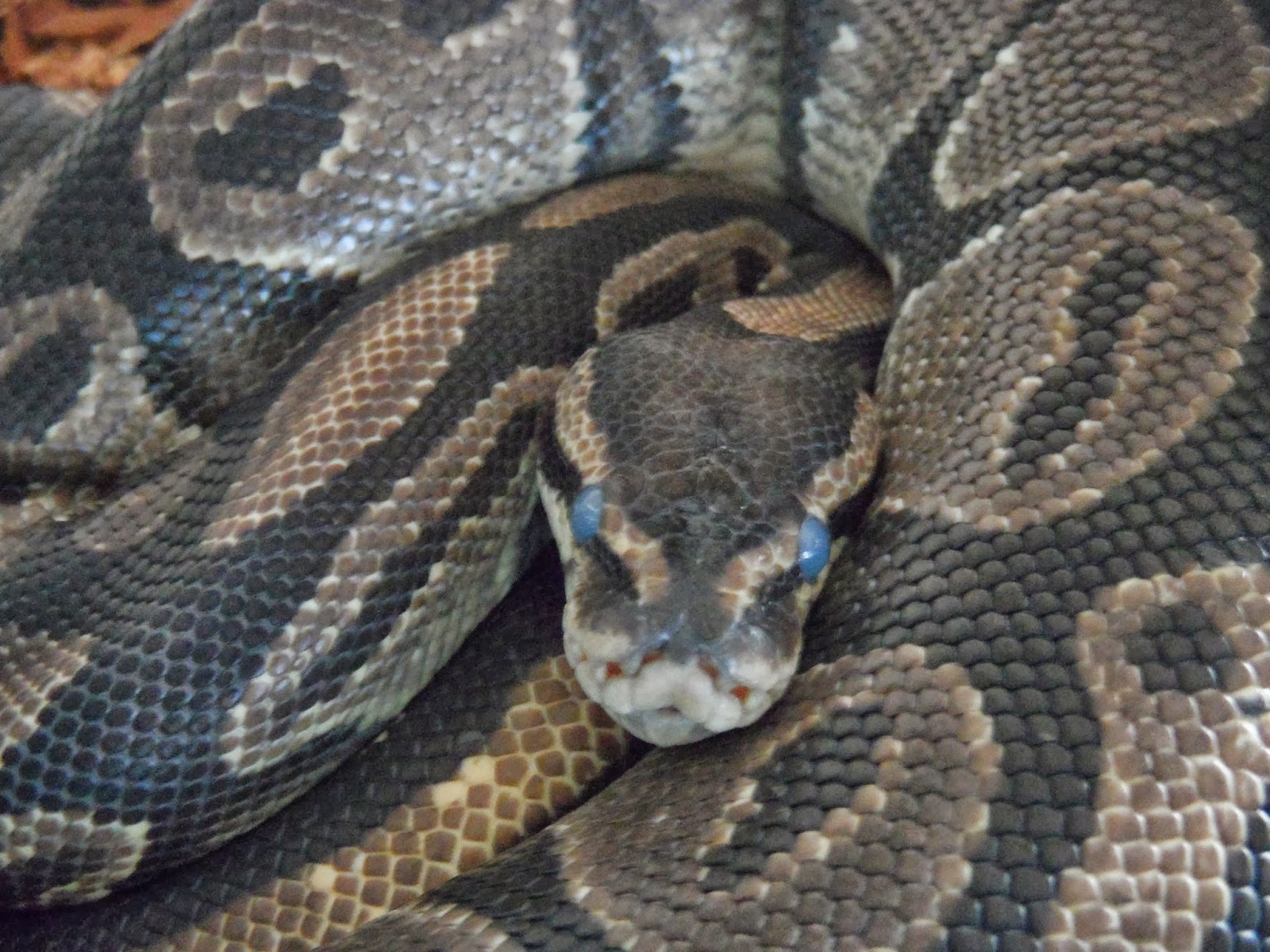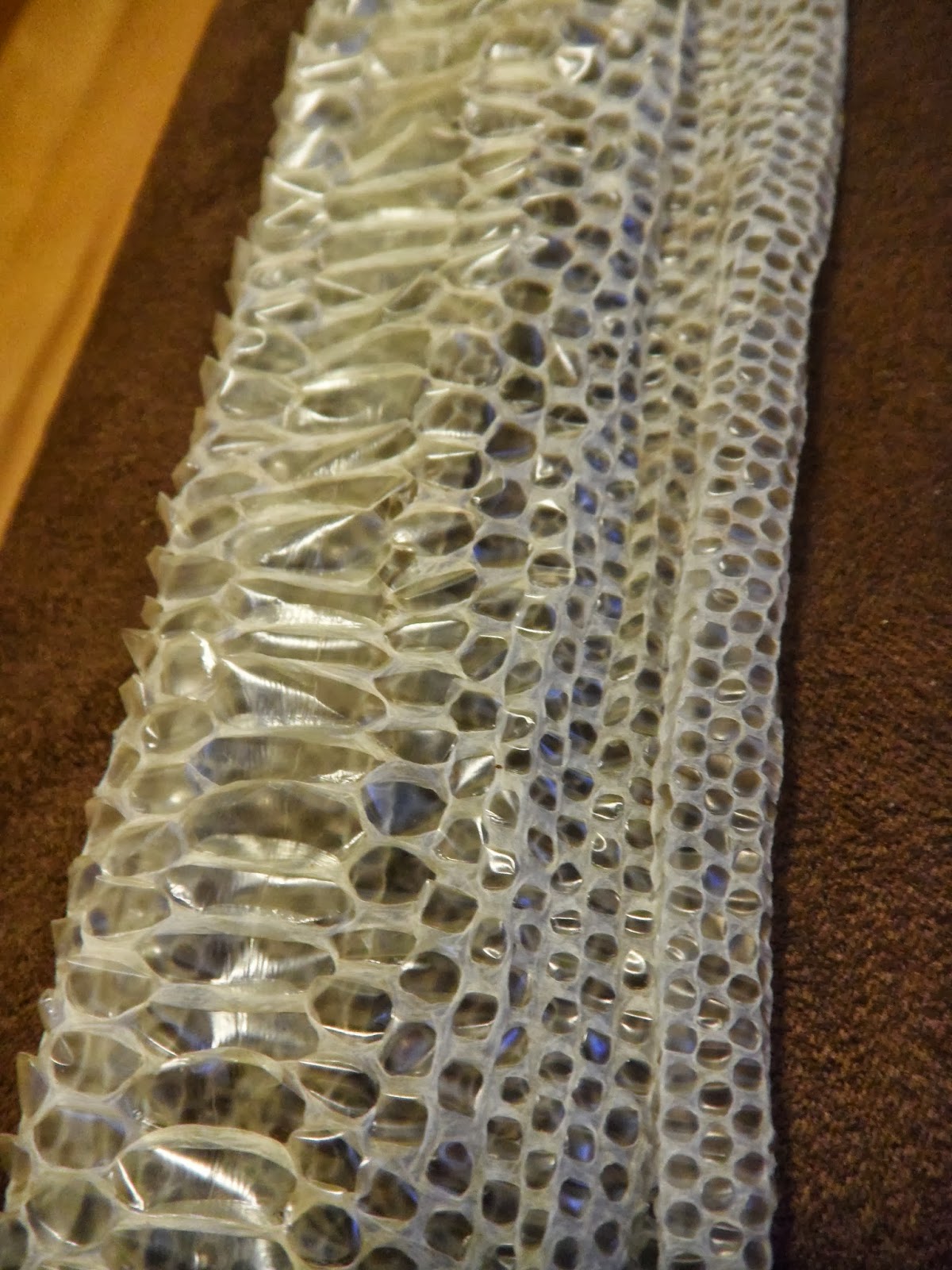This was the second time Jolene had shed since getting her. I had a better idea of what was going on this time around instead of wondering why she was sleeping all the time!
For ball pythons, the shedding process may take anywhere from 9-14 days. Most of that time is the pre-shed process, and the actual shedding of the skin doesn't take long at all. The outermost layer of a snake's skin is a continuous sheet of keratin that must be shed to allow for growth. A snake will shed every 4-6 weeks depending on its age.
Fun fact: Keratin can be found in reptiles, amphibians, fish, birds, and mammals. Humans' outer layer of skin, fingernails, and hair are made up of keratin. Many animal features are made of keratin as well, including scales, turtle shells, beaks, horns, hooves, feathers, claws, porcupine quills, and baleen plates in filter feeder whales.
For ball pythons, the shedding process may take anywhere from 9-14 days. Most of that time is the pre-shed process, and the actual shedding of the skin doesn't take long at all. The outermost layer of a snake's skin is a continuous sheet of keratin that must be shed to allow for growth. A snake will shed every 4-6 weeks depending on its age.
Fun fact: Keratin can be found in reptiles, amphibians, fish, birds, and mammals. Humans' outer layer of skin, fingernails, and hair are made up of keratin. Many animal features are made of keratin as well, including scales, turtle shells, beaks, horns, hooves, feathers, claws, porcupine quills, and baleen plates in filter feeder whales.
As far as ball pythons are concerned, one of the first signs of the shed cycle is a pink belly. At this first stage, the python can be given a bath, or more of a soak, in warm water. This will help them with shedding by hydrating their skin. So I gave that a shot.
Here is a close up of Jolene's pink belly.
Jolene soaking in the tub.
Another shot of her pink belly.
Another thing I've noticed when Jolene is going into shed mode is that she will sleep non-stop. It is not uncommon for a python to sleep for the entire week before shedding. Pythons do sleep a lot in general, but when they are in the pre-shed process, they won't even come out for their usual midnight stroll.
Dull skin is another physical sign a snake is about to shed. I've noticed this happens about 5 days into the shed cycle. The dull skin is due to the secretion of a lubricant beneath the upper layer of skin about to be shed. Anywhere between day 3-7 the snake will get cloudy eyes, a stage commonly called "in blue." This is caused by the same fluid build up between the new and old skin layers. Snakes have a scale over their eyes instead of an eyelid so the fluid is very noticeable in their eyes before shedding. Handling and feeding is not recommended at this stage. They usually don't have an appetite at this point, and they are visually impaired so it's best to leave them alone.
Notice her skin color at the beginning of the shed cycle.
Dull skin color near end of shed cycle.
"In Blue"
At day 7-10 the eyes will clear up, and within another couple days the snake will molt or slough (pronounced sluff) which means to get rid of old skin. Healthy snakes usually shed in a single piece. Poor nutrition and improper environmental conditions such as humidity can result in an incomplete shed.
Twelve days after I noticed her pink belly, Jolene finally shed. Prior to shedding I kept a close eye on humidity levels and misted her cage or put a towel over the enclosure to trap heat and moisture. She successfully shed in one piece!
Twelve days after I noticed her pink belly, Jolene finally shed. Prior to shedding I kept a close eye on humidity levels and misted her cage or put a towel over the enclosure to trap heat and moisture. She successfully shed in one piece!
Head shed, notice the eye scales.
For perspective, I'm 5'6". The shed measured a little over 4 feet when laid out.
Now that she had shed, I found her out and about, (the first time I saw her out of her hide in over 10 days!) so I got her out to take some pictures.
New shiny skin.
She may not be done growing. Female ball pythons can reach 5 feet.
The above pictures make her seem more brown than she actually is. Her dark patterns are more close to black and her new dark skin looks almost iridescent in the light. Here's a better example:


























